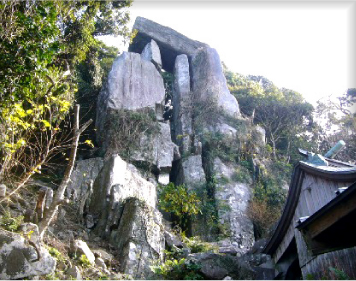

Behind Okinokojima shrine, there is a tower of gigantic rock formation which has been called "Oeishi" since ancient times.
The rock formation is 24 meters tall, two side columns span over 12 meters, and the area of the table top rock has the dimensions of 5 meters by 3 meters.
It is not known if the formation is an artifact or formed geologically.
One of the many myths about the rock says that a deity "Kojima myojin" once appeared on the top of the table rock.
*The route to the Oeishi area is not an easy trail. Please be careful and prepared when you hike there alone or without guides. Guided tour is also available. Please consider joining the tour.
Click for more detail>>
The rock formation is 24 meters tall, two side columns span over 12 meters, and the area of the table top rock has the dimensions of 5 meters by 3 meters.
It is not known if the formation is an artifact or formed geologically.
One of the many myths about the rock says that a deity "Kojima myojin" once appeared on the top of the table rock.
*The route to the Oeishi area is not an easy trail. Please be careful and prepared when you hike there alone or without guides. Guided tour is also available. Please consider joining the tour.
Click for more detail>>

This shrine is thought to be built in A.D. 704 (Asuka period) facing towards Okinokojima shrine on Ojika Island.
After long hike on a mountain trail, you will see the gigantic Oeishi rocks in thick virgin forest first, and then find the shrine right beneath the rocks. The last resident of the island was the shrine's priest, and he finally left the island in 2001.
*The route to the area is not an easy trail. Please be careful and prepared when you hike there alone or without guides. Guided tour is also available. Please consider joining the tour.
Click for more detail>>
After long hike on a mountain trail, you will see the gigantic Oeishi rocks in thick virgin forest first, and then find the shrine right beneath the rocks. The last resident of the island was the shrine's priest, and he finally left the island in 2001.
*The route to the area is not an easy trail. Please be careful and prepared when you hike there alone or without guides. Guided tour is also available. Please consider joining the tour.
Click for more detail>>
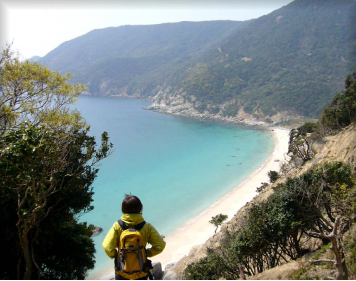

The beach is 300 meters long covered with white sands. Together with cobalt blue sea, the beauty of the beach will surely make you very excited.
The beach is located in the middle of eastern edge of Nozaki Island. It is the perfect spot to view the sunrise in the clear morning.
The beach is located in the middle of eastern edge of Nozaki Island. It is the perfect spot to view the sunrise in the clear morning.

The Nozaki settlement existed over the area around Nozaki harbor.
During the prime time of the island, hundreds of people lived in the area. As time went by, the population continuously dropped and the last resident of the settlement left the island in Autumn 2001.
Several old houses are barely but still standing and showing remnant of vivid daily lives of the residents.
During the prime time of the island, hundreds of people lived in the area. As time went by, the population continuously dropped and the last resident of the settlement left the island in Autumn 2001.
Several old houses are barely but still standing and showing remnant of vivid daily lives of the residents.
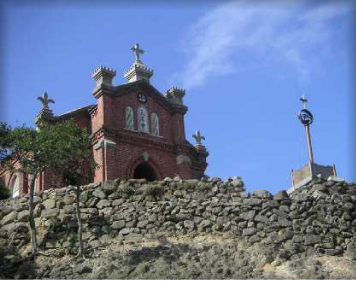

Nature-learning village and Nokubi church are in the center part of the former Nokubi settlement.About 200 people used to live there at the prime time.
None of the houses exists now, but we can still imagine the atmosphere of the settlement and people's activities from remaining stonewalls and broken pieces of roof tiles left on the ground.
It is said that the conditions for cultivation of the land was much harder in this area, than the Nozaki settlement.
None of the houses exists now, but we can still imagine the atmosphere of the settlement and people's activities from remaining stonewalls and broken pieces of roof tiles left on the ground.
It is said that the conditions for cultivation of the land was much harder in this area, than the Nozaki settlement.
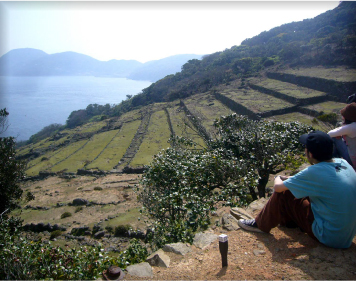

The ruins of Funamori at the south edge of the island is located a little bit far from other two settlements.
During the anti-Christian policy era of Japan, this settlement was of secret Christians.
What we can see now is only remnant of stonewalled terraced fields on the very steep slope face. The sight of this countless number of the terraced fields cultivated and plowed only by physical labor of humans and oxen is quite awe-inspiring.
During the anti-Christian policy era of Japan, this settlement was of secret Christians.
What we can see now is only remnant of stonewalled terraced fields on the very steep slope face. The sight of this countless number of the terraced fields cultivated and plowed only by physical labor of humans and oxen is quite awe-inspiring.

The Nozaki harbor is the island's main entry point where the municipal "Hamayu" arrives at.
Also, it is one of the popular fishing spots where a wide variety of fish can be seen such as horse mackerel, red barracuda, and marbled rockfish.
Nature-learning village is located within 20-minute walking distance from the harbor.
Also, it is one of the popular fishing spots where a wide variety of fish can be seen such as horse mackerel, red barracuda, and marbled rockfish.
Nature-learning village is located within 20-minute walking distance from the harbor.

The Nokubi harbor is located on the west side of the island and just bellow Nozaki dam.
It takes about 15 minutes to go to Fuefuki harbor on Ojika Island from this harbor using a chartered ferry.
Nature-learning village is located within 15-minute walking distance from the harbor.
It takes about 15 minutes to go to Fuefuki harbor on Ojika Island from this harbor using a chartered ferry.
Nature-learning village is located within 15-minute walking distance from the harbor.
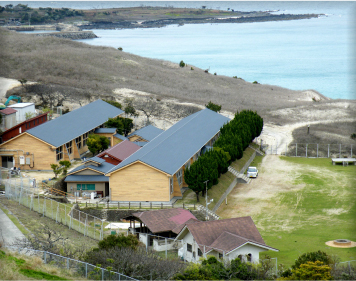

The nature-learning village is the island's only rest-area/accomodation facility. Former elementary/junior high school buildings were reformed and converted in to the facility.
It takes just a minute to Nokubi church or Nokubi beach on foot.
Click for more detail>>
It takes just a minute to Nokubi church or Nokubi beach on foot.
Click for more detail>>













